Saturday, September 17, 2005
A Tale of Two Hospitals
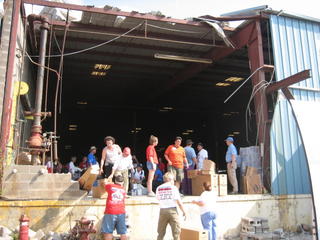 On Thursday, September 15, Myhanh and I met Kim at the relocated Red Cross health care headquarters in Gulfport. As you can see from the photo, the air conditioning is now more natural, with breezes coming off the Gulf. We then set out to assess the health care facilities in Bay St. Louis, where the local hospital, Hancock Memorial, had been flooded and was closed.
On Thursday, September 15, Myhanh and I met Kim at the relocated Red Cross health care headquarters in Gulfport. As you can see from the photo, the air conditioning is now more natural, with breezes coming off the Gulf. We then set out to assess the health care facilities in Bay St. Louis, where the local hospital, Hancock Memorial, had been flooded and was closed.The drive down to Bay St. Louis showed more scenes of the awesome power of the storm; cars overturned, strewn around the side of the road.
 Here’s what we found at Hancock Memorial: a beautiful campus and facility from the outside—washed clean, I guess.
Here’s what we found at Hancock Memorial: a beautiful campus and facility from the outside—washed clean, I guess.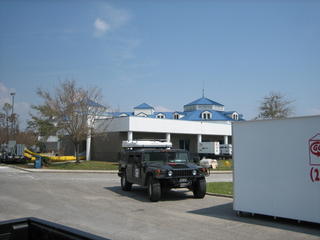 In front, a bunch of containers; to the side, a tent city of military folks; and under the front portico, nurses enjoying a lunch of tuna salad.
In front, a bunch of containers; to the side, a tent city of military folks; and under the front portico, nurses enjoying a lunch of tuna salad.
Angie Gambino is the Chief Nursing Officer of Hancock, and she gave us a tour—probably very experienced at this by now. On the night of the hurricane, the staff transported all the patients to the first floor because of fear of hurricane winds. Then as word came of the flooding, they transported the patients back upstairs—all except one 600-pound man who had had to be carried downstairs by the National Guard and who was evacuated rather than carry him back upstairs.
They then watched through the second-story windows as the parking lot filled with waters from the Gulf of Mexico, usually 5 miles away. Angie saw her Dodge Durango SUV disappear under the water, then saw the parking lot filled with whitecaps (‘nurses’). They must have been terrified.
Angie praises God that they did not lose any patients or staff; but 70% of their staff had their homes destroyed. Their two outlying clinics were also destroyed. Now here is her staff having a leisurely picnic under the portico, enjoying the Gulf breeze, cheerful as can be. “We can make it”, said one nurse with a lovely smile.
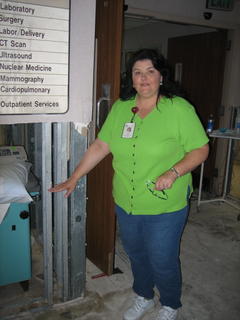 Angie shows the level that the water reached inside the hospital’s first floor; the hospital is on a small rise so it wasn’t as bad as it could have been. The hospital has steel studs and a concrete slab floor; so once the wet wallboard is removed it should be sound again soon.
Angie shows the level that the water reached inside the hospital’s first floor; the hospital is on a small rise so it wasn’t as bad as it could have been. The hospital has steel studs and a concrete slab floor; so once the wet wallboard is removed it should be sound again soon.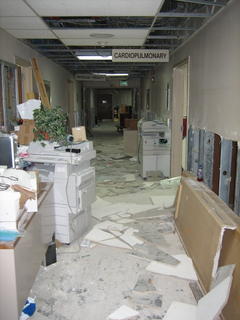 Here's the way the corridor looks now.
Here's the way the corridor looks now.The medical equipment did not fare as well. The photo to the lower left shows a pile of it out in the patio, ruined.
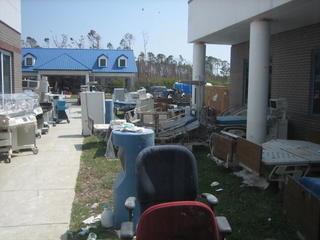
Angie shows us part of the floor where they were testing a new woodgrain vinyl tile. Other than the dirt tracked in, it is pristine. A great ad for the tile.
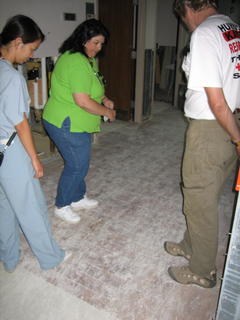
Back in front of the hospital (after the nurses shared their lunch with us), Angie told us that the containers are loaded with equipment and supplies to restock the hospital and their outlying clinics in Kiln and Waveland. Mobile homes will be used as facilities for the clinics. Angie gives us what seems like a wildly optimistic re-start date for the hospital of October.
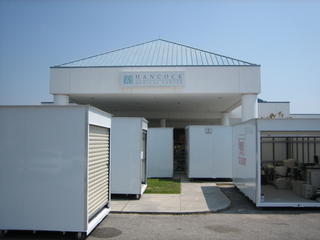 We leave Hancock humbled and awed by the spirit of the nurses despite their own terrible losses. The local physicians, by the way, all lost their office buildings. If the community wants them to stay, they'll clearly need some help rebuilding. I have no doubt the community is going to work together and rebuild it better than before.
We leave Hancock humbled and awed by the spirit of the nurses despite their own terrible losses. The local physicians, by the way, all lost their office buildings. If the community wants them to stay, they'll clearly need some help rebuilding. I have no doubt the community is going to work together and rebuild it better than before.We drove a few miles east on Pass Road to see a little of Bay St. Louis. Here is a photo of their Bay Bridge, with only the pylons standing, the deck entirely swept away. This must be a popular site to take pictures for us disaster tourists; there were four porta-pottis so no need to wait.
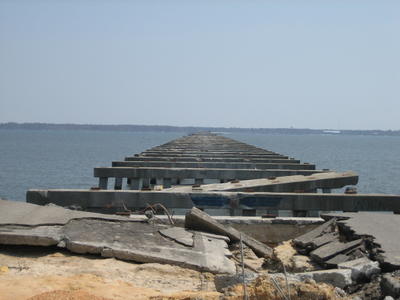 Back down Pass Road, we find the hand-drawn sign that says “Field Hospital”. Frankly, we didn’t look when we came by before because the signage was so crude. It turns out that’s the only crude thing about an enormously impressive operation.
Back down Pass Road, we find the hand-drawn sign that says “Field Hospital”. Frankly, we didn’t look when we came by before because the signage was so crude. It turns out that’s the only crude thing about an enormously impressive operation.  Here in the K-Mart parking lot (9 bodies were found on the K-Mart roof, such was the flood level here) is the world’s first complete mobile trailer-based hospital, Med-1 from North Carolina. Surrounding it is a Barnum and Bailey tent town of supplies, clothes (“I’d like something in blue,” whispers Kim)
Here in the K-Mart parking lot (9 bodies were found on the K-Mart roof, such was the flood level here) is the world’s first complete mobile trailer-based hospital, Med-1 from North Carolina. Surrounding it is a Barnum and Bailey tent town of supplies, clothes (“I’d like something in blue,” whispers Kim) 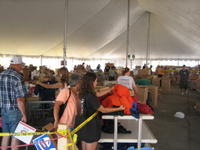 and representatives from FEMA and the Small Business Administration. An aid station is giving out tetanus shots; another tent is for triage.
and representatives from FEMA and the Small Business Administration. An aid station is giving out tetanus shots; another tent is for triage.We come to the Men in Black—a SWAT team from North Carolina intent on not letting any questionable characters into their priceless facility. Well, actually it’s not priceless, it cost FEMA $1.5 million, and it’s doubtful they’ve ever spent any money as wisely. After a radio call, we are met by the public affairs officer, Alan Taylor, who gives us the official tour. The mobile rig—a trailer much like a NASCAR support trailer—has side wings that triple its size when expanded. It is accompanied by a support trailer—a two-level job, again modeled after NASCAR—that carries the equipment and supplies when Med-1 is on the road.
 Surrounding us is a circus-sized tent, air-conditioned, with power supplied by the generator in the tractor that pulls the hospital. On one side, the urgent care area (photo on the right); on the other, an area that can serve as a ward for hospitalized patients.
Surrounding us is a circus-sized tent, air-conditioned, with power supplied by the generator in the tractor that pulls the hospital. On one side, the urgent care area (photo on the right); on the other, an area that can serve as a ward for hospitalized patients. The hospital itself is completely self-contained: it has its own lab, ultrasound, digital radiography, a 4-bed CCU/ICU, an integrated medical information system, and a 1-bed OR.
The hospital itself is completely self-contained: it has its own lab, ultrasound, digital radiography, a 4-bed CCU/ICU, an integrated medical information system, and a 1-bed OR. 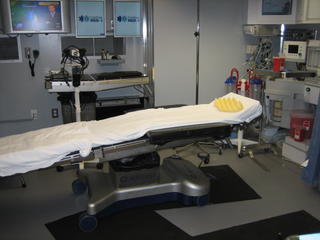
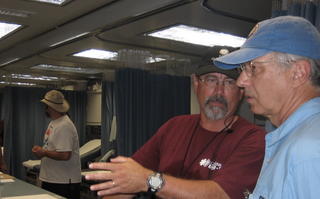
How did this marvel come to be? Dr. Tom Blackwell of Carolinas Medical Center had it already designed after prolonged research and analysis, when FEMA expressed an interest. According to Mr. Taylor, FEMA was expecting a very long process to acquire such capability, when Dr. Blackwell offered to fax the complete proposal. This during a conference call; and apparently Dr. Blackwell’s offer was met first with stunned silence, then with an astonished “What did you say?” Dr. Blackwell got his grant of $1.5 million from FEMA to build it. Mind you, we’d been told by one of our Humvee acquaintances that the support coach that accompanies them—a real luxury RV—would cost about a million on its own.
Speaking of luxury: here's the most recent modification of
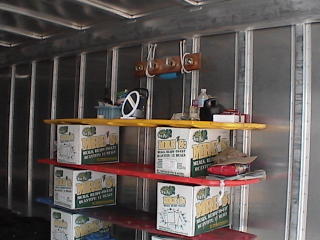 the system. Dr. Blackwell is a guy, so the support trailer has a big TV and a comfortable lounge. What he did not count on was the needs of the female nurses. Here's how they provided the needed equipment: yes, that is a vanity, complete with Hollywood lights for the mirror. Go, nurses!
the system. Dr. Blackwell is a guy, so the support trailer has a big TV and a comfortable lounge. What he did not count on was the needs of the female nurses. Here's how they provided the needed equipment: yes, that is a vanity, complete with Hollywood lights for the mirror. Go, nurses!I think FEMA got a great bargain. FEMA, the military, and some of the states such as Florida have looked at this prototype, so more may be built. Working with the military, the North Carolina folks were able to cut two inches off the dimensions, and that made the whole facility transportable by C-17 or C-5A. You like it? I may be able to get you a good deal on one. Have your governor call me.
This time, its first deployment, was a little more problematic. The Med-1 team was ready to go just after the storm; an agreement between the governor of North Carolina and Governor Blanco of Louisiana was prepared and faxed to Governor Blanco. 24 hours elapsed and the agreement was not signed. The team was ready to leave on Friday, September 2, and the agreement was not signed. The team was then federalized by FEMA and ordered to deploy. They made it as far as Mississippi—still no agreement. So instead of heading for Louisiana, Med-1 came to Bay St. Louis, where it serves as a temporary replacement for Hancock Memorial while the latter is out of commission. Although they have a mobile CT scanner as well (arranged by the Director of Hancock Memorial), Med-1 does not try to be a full-service hospital. They can do emergency surgery, but more sophisticated specialty surgery and large-scale hospital care is beyond their capability. What they can do is treat the more common things, stabilize critically-ill patients, and evacuate those they cannot handle. One can imagine that several of these rigs would be a Godsend to a devastated state in a natural disaster—provided the governor asks for it.
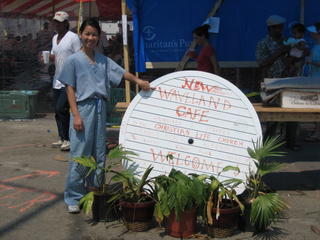 Here is Myhanh in front of the New--and Improved--Waveland Cafe, where Christian Life feeds thousands every day. I don't know how many loaves and fishes they have left over, but they and other Chrsitian groups are doing a wonderful job of serving here. If you sent your donation to one of the Christian church denominations doing relief work, you did well. The Southern Baptist effort is particularly visible, but I've lost track of the names of the church-based or other Christian groups I've seen at work here. God has blessed you to be a blessing.
Here is Myhanh in front of the New--and Improved--Waveland Cafe, where Christian Life feeds thousands every day. I don't know how many loaves and fishes they have left over, but they and other Chrsitian groups are doing a wonderful job of serving here. If you sent your donation to one of the Christian church denominations doing relief work, you did well. The Southern Baptist effort is particularly visible, but I've lost track of the names of the church-based or other Christian groups I've seen at work here. God has blessed you to be a blessing.So... um... do we get to know the brand of flooring that stood up so well to flooding?
I can only add that the manner in which you are reporting what is happening is very articulate. It is devoid of media sensationalism (also known as mushroom fodder).
<< Home

